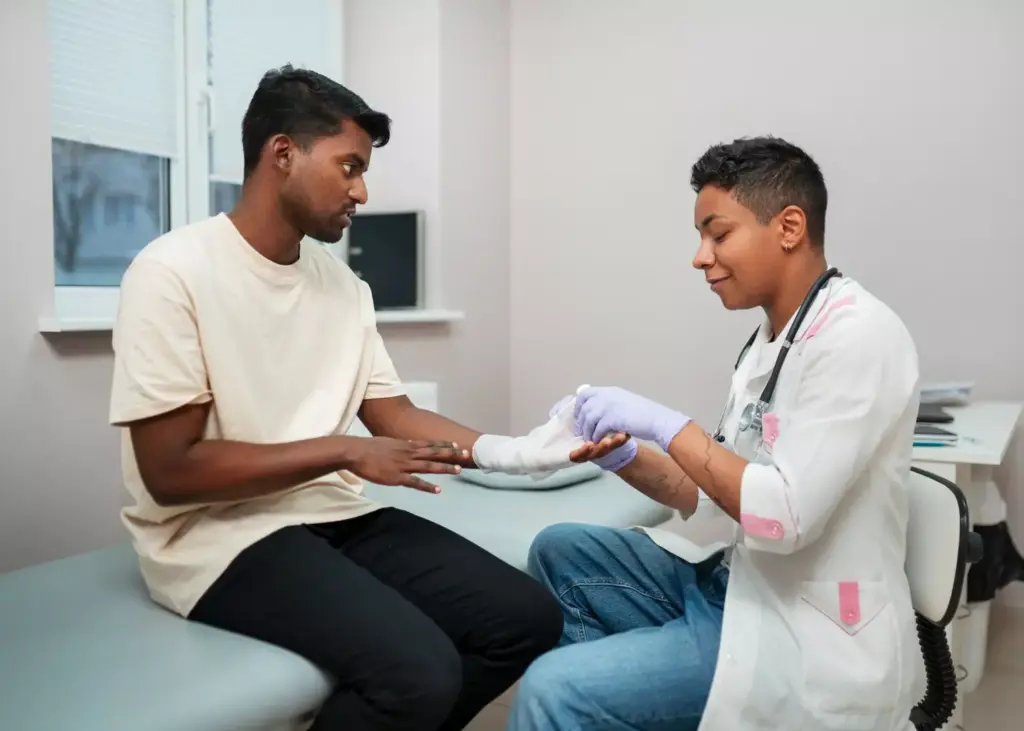Last Updated on November 26, 2025 by Bilal Hasdemir

At Liv Hospital, we know how complex non-small cell lung cancer (NSCLC) is. We also know how vital it is to find the best treatments. NSCLC makes up about 85% of lung cancer cases. Thanks to new discoveries, treatments are getting better, and survival chances are rising.
For early-stage NSCLC, surgery can be a cure. This is true when it’s paired with targeted therapy or immunotherapy. We put our patients first. We use the latest in precision medicine and new therapies to change the game for NSCLC patients.
Key Takeaways
- NSCLC accounts for approximately 85% of lung cancer cases.
- Early-stage NSCLC may be curable with surgery and adjuvant therapies.
- Targeted therapy and immunotherapy have shown efficacy in treating NSCLC.
- Patients with EGFR mutations respond well to EGFR inhibitors.
- Cure rates for Stage I NSCLC can be between 70% to 90% with the right treatment.
Understanding Non-Small Cell Lung Cancer (NSCLC)
Getting a handle on NSCLC means knowing its types and stages. This knowledge is key to better care for patients. NSCLC makes up about 85% of lung cancer cases, making it the most common type.
Types of NSCLC
NSCLC isn’t just one disease; it’s several types. These include adenocarcinoma, squamous cell carcinoma, and large cell carcinoma. Each type needs its own treatment plan.
- Adenocarcinoma: This is the most common type, often found in non-smokers. It has specific genetic changes.
- Squamous Cell Carcinoma: Linked to smoking, this type grows fast.
- Large Cell Carcinoma: This is a catch-all for NSCLC that doesn’t fit into other categories.
Staging and Its Importance in Treatment Planning
Staging NSCLC is vital for planning treatment. It looks at the tumor size, lymph nodes, and if the cancer has spread.
- Early-stage NSCLC: Usually treated with surgery or local treatments.
- Advanced NSCLC: Needs systemic treatments like chemotherapy, targeted therapy, or immunotherapy.
Key Statistics and Prevalence
NSCLC is a big health problem worldwide. Knowing its numbers helps with planning and research.
- NSCLC makes up about 85% of lung cancer cases.
- The 5-year survival rate changes a lot based on when the cancer is found.
Understanding NSCLC types, stages, and stats helps doctors give better care. This leads to better results for patients.
Is Non Small Cell Lung Cancer Curable? Factors Affecting Prognosis
To figure out if NSCLC is curable, we look at the stage, genetic profiles, and patient factors. Each of these plays a big role in how well a patient might do. So, it’s key to check them all for the best treatment plan.
Stage at Diagnosis
The stage of NSCLC at diagnosis is very important. Early stages can often be treated with surgery and more. But, if it’s advanced, treatments like chemotherapy and radiation might be needed.
Key considerations for stage at diagnosis include:
- The extent of tumor spread
- Lymph node involvement
- Presence of metastasis
Getting the stage right helps pick the right treatment and guess how well a patient will do.
Genetic and Molecular Profiles
The genes and molecules in NSCLC tumors affect how they grow and react to treatment. For example, some tumors with EGFR mutations can be treated with special drugs. A study on treatment for EGFR-mutant NSCLC shows how important it is to know these genetic details.
Key genetic and molecular factors include:
- EGFR mutations
- ALK rearrangements
- ROS1 fusions
Knowing these genetic profiles helps doctors create treatments that fit each patient’s tumor.
Patient-Specific Factors
Things like a patient’s health, age, and how well they can function also matter. Patients who are healthier and can function better usually do better.
Important patient-specific factors to consider are:
- Age and overall health
- Performance status
- Presence of comorbidities
By looking at these factors, doctors can make treatment plans that are just right for each patient.
Early-Stage NSCLC Treatment Options
Early-stage NSCLC offers a chance for treatment with several options. We’ll look at surgical methods, radiation therapy, and adjuvant therapy.
Surgical Approaches and Innovations
Surgery is key in treating early-stage NSCLC. Lobectomy, removing the whole lobe, is often the go-to. But for smaller tumors or less lung function, segmentectomy or sublobar resection might be better.
New surgical techniques like video-assisted thoracic surgery (VATS) and robotic-assisted surgery are making things better. They help patients recover faster and have fewer problems.
| Surgical Procedure | Description | Benefits |
|---|---|---|
| Lobectomy | Removal of the entire lobe | Standard procedure, effective for larger tumors |
| Segmentectomy | Removal of a lung segment | Spares more lung tissue, suitable for smaller tumors |
| VATS/Robotic Surgery | Minimally invasive techniques | Less recovery time, fewer complications |
Radiation Therapy for Localized Disease
For those not suited for surgery or who don’t want it, radiation therapy is a good choice. Stereotactic body radiation therapy (SBRT) gives precise, high doses to tumors. It works well to control tumors locally.
Adjuvant Therapy to Prevent Recurrence
After surgery or radiation, adjuvant therapy might be needed. It aims to get rid of any cancer cells left behind and lower the chance of cancer coming back. Chemotherapy and targeted therapy are common, chosen based on the tumor.
Adjuvant therapy is a big part of care. It helps patients live longer and might avoid the need for more treatment.
Advanced Treatment Protocols for Locally Advanced NSCLC
Locally advanced NSCLC needs a detailed treatment plan. This might include chemoradiation therapy and neoadjuvant treatment. We will look at the advanced treatment options for locally advanced NSCLC. We focus on combining different treatments to help patients more.
Multimodal Treatment Approaches
A multimodal treatment approach is key for locally advanced NSCLC. It combines chemotherapy, radiation therapy, and surgery. This strategy aims to treat the disease from all sides for better results.
By mixing these treatments, we can target cancer more effectively. For example, chemotherapy and radiation therapy together can shrink tumors. This makes them easier to remove surgically.
Chemoradiation Therapy
Chemoradiation therapy is a common treatment for locally advanced NSCLC. It combines chemotherapy and radiation therapy. This makes radiation work better by making cancer cells more sensitive to it.
Studies have shown that chemoradiation therapy can improve survival rates. For example, a study on Zongertinib showed it’s effective against advanced NSCLC with certain mutations.
Neoadjuvant Treatment Strategies
Neoadjuvant treatment is given before the main treatment, usually surgery. Its goal in locally advanced NSCLC is to shrink tumors. This makes them easier to remove surgically and can improve surgery results.
We use neoadjuvant chemotherapy or chemoradiation therapy for locally advanced NSCLC. This helps downstage the disease. It increases the chances of a successful surgical resection.
Metastatic Non-Small Cell Lung Cancer Treatment Advances
Metastatic non-small cell lung cancer (NSCLC) treatment has seen big changes. Now, we use many ways to treat this tough disease. This approach helps patients live better and longer.
First-Line Treatment Options
The first treatment for metastatic NSCLC has changed a lot. Now, we use chemotherapy, targeted therapy, and immunotherapy. Targeted therapy works best for those with certain genetic changes, like EGFR or ALK.
Immunotherapy, like checkpoint inhibitors, has also shown great results. It helps some patients live longer.
- Chemotherapy is key for those without certain genetic changes.
- Targeted therapy is tailored for specific genetic profiles.
- Immunotherapy has brought new hope for better survival.
Management of Brain Metastases
Brain metastases are a big problem in metastatic NSCLC. We need a team effort to manage them. Treatments include stereotactic radiosurgery (SRS), whole-brain radiation therapy (WBRT), and surgery.
Choosing the right treatment depends on many things. We consider the size and location of the metastases, and how well the patient is doing.
Palliative Care Integration
Palliative care is very important in treating metastatic NSCLC. It focuses on easing symptoms, managing pain, and improving life quality. Early palliative care can make a big difference.
It’s key to have a care plan that includes both disease treatment and palliative care. This way, patients get the support they need every step of the way.
Targeted Therapies Revolutionizing NSCLC Treatment
Recently, targeted therapies have changed how we treat NSCLC. They offer treatments that match the tumor’s genetic makeup. This makes treatment more effective by focusing on the cancer’s specific traits.
EGFR Inhibitors and Their Applications
EGFR inhibitors, like erlotinib and gefitinib, work well for NSCLC with EGFR mutations. These mutations are found in 10-15% of NSCLC cases in the West. They are more common in non-smokers and those with adenocarcinoma. EGFR inhibitors are key in treating these patients, leading to better response and longer survival than traditional chemotherapy.
“The introduction of EGFR inhibitors has been a big step forward in NSCLC treatment,” says a top oncologist. “It offers a targeted approach that boosts patient outcomes.”
ALK, ROS1, and Other Targetable Mutations
NSCLC also has ALK and ROS1 rearrangements that can be targeted. ALK inhibitors, such as crizotinib and alectinib, help those with ALK rearrangements. ROS1 inhibitors are also showing promise for ROS1 rearrangements. Discovering these mutations has opened up more treatment options for NSCLC patients, showing the value of detailed genetic testing.
Resistance Mechanisms and Newer Generation Drugs
Even with targeted therapies, resistance can develop, reducing their long-term effectiveness. It’s vital to understand these resistance mechanisms. Newer ALK inhibitors are being made to beat resistance to older ones. The development of new targeted therapies is essential to bettering NSCLC patient outcomes.
Dr. Alice Shaw, a lung cancer expert, says, “Targeted therapies have greatly changed NSCLC treatment. Ongoing research will keep improving patient results.”
Immunotherapy as a Cornerstone in NSCLC Management
Immunotherapy is now a key part of treating NSCLC. It uses checkpoint inhibitors to change how we fight cancer. This has opened up new ways to help patients live longer.
Checkpoint Inhibitors and Their Mechanisms
Checkpoint inhibitors are a new type of drug for NSCLC. They let the immune system attack cancer cells better. Drugs like pembrolizumab and nivolumab have shown they can help patients live longer.
These drugs work by stopping proteins that slow down the immune system. This lets the immune system fight cancer cells more effectively.
Biomarkers for Immunotherapy Response
Biomarkers help doctors know who will benefit from immunotherapy. PD-L1 is a key biomarker for NSCLC. Patients with high PD-L1 levels often do better with these drugs.
| Biomarker | Description | Clinical Significance |
|---|---|---|
| PD-L1 Expression | Measures the level of PD-L1 protein on tumor cells | Predicts response to checkpoint inhibitors |
| Tumor Mutational Burden (TMB) | Quantifies the number of mutations within a tumor | Higher TMB associated with better response to immunotherapy |
| Microsatellite Instability (MSI) | Measures genetic instability due to DNA repair defects | MSI-high tumors may respond well to immunotherapy |
Combination Approaches with Immunotherapy
Doctors are trying different combinations of treatments with immunotherapy. Mixing checkpoint inhibitors with other drugs or therapies is showing great promise. This could lead to even better results for patients.
“The future of NSCLC treatment lies in the strategic combination of immunotherapies with other modalities, promising more effective and lasting responses.” –
Immunotherapy is changing how we treat NSCLC. As research grows, we’ll see even more ways to fight this disease.
Non Small Cell Squamous Lung Cancer: Specific Treatment Considerations
Squamous cell carcinoma, a type of NSCLC, needs special treatment. It faces unique challenges and complexities. We will look at the tailored approaches and new therapies helping to manage it.
Unique Challenges in Squamous Cell Carcinoma
Squamous cell carcinoma is hard to treat, with few options. Genetic mutations and tumor location add to the complexity. Its central location can lead to bleeding risks due to blood vessel proximity.
“Managing squamous cell lung cancer is tough because of its unique molecular profile and limited targeted therapies,” experts say.
Tailored Treatment Approaches
Customized treatments are key for success. Chemotherapy and radiation therapy are common for squamous cell carcinoma. The choice depends on tumor stage, location, and patient health.
- Chemotherapy is often paired with radiation to boost effectiveness.
- Radiation helps control tumors and ease symptoms.
Emerging Therapies for Squamous Histology
New therapies, like immunotherapy and targeted therapy, are being tested. Immunotherapy shows great promise for squamous cell carcinoma.
Recent studies show checkpoint inhibitors are effective against squamous cell carcinoma. This offers new hope for patients. “Immunotherapy has changed the treatment landscape for NSCLC, including squamous cell carcinoma,” a leading oncologist notes.
Precision Medicine in NSCLC: Tailoring Treatment to Individual Patients
Precision medicine is changing how we treat non-small cell lung cancer (NSCLC). It tailors treatments to fit each patient’s needs. This new way of treating NSCLC makes care more effective and focused.
Comprehensive Genomic Profiling
Comprehensive genomic profiling (CGP) is key in precision medicine for NSCLC. It looks at the genetic changes in tumors to find therapy targets. This helps us create treatment plans that work better for each patient.
The benefits of CGP include:
- Identifying mutations that can be treated
- Choosing the right targeted therapy
- Understanding the tumor better
Liquid Biopsy and Treatment Monitoring
Liquid biopsy is a new tool in precision medicine. It checks the blood for tumor DNA to see how treatments are working. This method lets us change treatments as needed, helping patients more.
The advantages of liquid biopsy include:
- Watching how treatments work without invasive tests
- Finding mutations that make treatments fail early
- Making treatment changes quickly
Future Directions in Personalized Care
Precision medicine is getting even better for NSCLC treatment. We’re seeing new things like using artificial intelligence to understand complex genetic data. This will help us give even more personalized care.
Key areas of research include:
- Getting better at using liquid biopsy
- Finding new treatments for resistant tumors
- Trying new combinations of treatments
By moving forward with these advancements, we can keep improving care for NSCLC patients. We’re getting closer to our goal of top-notch, personalized care for everyone.
Emerging Therapies and Clinical Trials for NSCLC
New treatments like bispecific antibodies and antibody-drug conjugates are changing how we fight NSCLC. These new methods are being tested in clinical trials. They offer hope to those with advanced or hard-to-treat disease.
Bispecific Antibodies and Novel Immunotherapies
Bispecific antibodies can hit two targets at once. This makes them powerful against NSCLC. Early trials show they can shrink tumors a lot.
This is a big step forward in fighting cancer. It might work better than older treatments.
Antibody-Drug Conjugates
Antibody-drug conjugates (ADCs) are a mix of antibodies and drugs. They find cancer cells and kill them without harming healthy cells. They’re showing great promise in NSCLC trials.
| Therapy Type | Mechanism of Action | Clinical Trial Outcomes |
|---|---|---|
| Bispecific Antibodies | Targets two antigens/epitopes, enhances immune response | Promising results with significant tumor reduction |
| Antibody-Drug Conjugates | Delivers cytotoxic drug directly to tumor cells | Considerable promise with minimized side effects |
How to Access Clinical Trials
Looking into clinical trials is a good option for NSCLC patients. Patients can find trials on ClinicalTrials.gov or talk to their doctor.
It’s key to talk about the good and bad of trials with your doctor. This helps you make a smart choice.
NSCLC Survival Rates and Quality of Life Considerations
Medical technology is getting better, and so is our focus on NSCLC survival rates and quality of life. We’re not just aiming to increase survival rates. We also want to make sure patients have a good quality of life during their treatment.
Current Survival Statistics by Stage
NSCLC survival rates change a lot based on the stage of diagnosis. Early-stage NSCLC usually has a better outlook than later stages.
| Stage at Diagnosis | 5-Year Survival Rate |
|---|---|
| Stage I | 60-80% |
| Stage II | 40-60% |
| Stage III | 20-40% |
| Stage IV | less than 20% |
These numbers show why catching NSCLC early is so important. We’re working hard to improve these numbers with better treatments and care.
Managing Treatment Side Effects
It’s key to manage side effects to keep quality of life high. We use many ways to lessen treatment side effects, such as:
- Advanced anti-emetic medications to control nausea
- Nutritional counseling to keep strength and energy up
- Pain management programs made just for each person
- Rehabilitation services to help get back physical function
As one patient said,
“The support I got during my treatment was a game-changer. It wasn’t just about living; it was about living with dignity.”
Supportive Care and Rehabilitation
Supportive care and rehabilitation are key in managing NSCLC. We have programs that include:
- Palliative care to boost quality of life
- Physical therapy to regain strength and mobility
- Psychological support to deal with cancer’s emotional side
- Survivorship programs for patients after treatment
We know NSCLC survival rates are getting better. But, quality of life is just as important for patients. By focusing on both survival and managing side effects, we aim to give complete care to our patients.
Conclusion: The Evolving Landscape of NSCLC Treatment and Hope for Patients
The treatment for non-small cell lung cancer (NSCLC) is changing fast. This brings new hope to patients. New treatments like targeted therapies and immunotherapy are making a big difference. They help doctors tailor care to each patient’s needs.
Now, we focus more on precision medicine. Tests like liquid biopsy help plan treatments. New drugs like bispecific antibodies are also being developed. These changes offer more options for patients.
Research and clinical trials keep improving NSCLC treatments. This means better care for patients. As we keep moving forward, NSCLC treatment will continue to get better.
For patients, this means a brighter outlook and more treatment choices. We’re dedicated to top-notch healthcare for everyone. This includes support for patients from around the world, ensuring they get the best care.
FAQ
What is Non-Small Cell Lung Cancer (NSCLC) and how is it different from other types of lung cancer?
NSCLC is a common type of lung cancer. It’s different from Small Cell Lung Cancer (SCLC) because of its cell structure and behavior. NSCLC includes subtypes like adenocarcinoma, squamous cell carcinoma, and large cell carcinoma.
What are the stages of NSCLC and how do they impact treatment planning?
NSCLC is staged from I to IV based on tumor spread. The stage at diagnosis is key for treatment planning. Early-stage disease might be treated with surgery or localized therapies. Advanced disease often needs systemic treatments like chemotherapy or immunotherapy.
Is NSCLC curable, and what factors affect its prognosis?
NSCLC’s curability depends on several factors. These include the stage at diagnosis, genetic profiles, and patient-specific factors. Early-stage disease can often be cured with surgery or localized therapies. Advanced disease is generally not curable but can be managed to improve quality of life and survival.
What are the treatment options available for early-stage NSCLC?
Early-stage NSCLC can be treated with surgery, radiation therapy, or adjuvant therapy. The choice depends on the stage, tumor location, and patient health.
What are the latest advances in targeted therapies for NSCLC?
Targeted therapies for NSCLC include EGFR, ALK, and ROS1 inhibitors. These target specific genetic mutations. Newer drugs are being developed to overcome resistance, improving treatment options for patients with certain genetic profiles.
How does immunotherapy work in the management of NSCLC?
Immunotherapy, like checkpoint inhibitors, boosts the immune system’s fight against cancer cells. Biomarkers help predict who will respond best. Combination therapies with chemotherapy and targeted therapy are being explored to enhance treatment results.
What are the specific treatment considerations for non-small cell squamous lung cancer?
Non-small cell squamous lung cancer needs tailored treatments. Options include chemotherapy and radiation therapy. New therapies like immunotherapy and targeted therapy are being developed to improve outcomes.
How does precision medicine impact the treatment of NSCLC?
Precision medicine, including genetic profiling and liquid biopsy, tailors treatments to individual patients. This approach is changing NSCLC treatment, leading to better outcomes and quality of life.
What are the emerging therapies being developed for NSCLC?
New therapies for NSCLC include bispecific antibodies, antibody-drug conjugates, and novel immunotherapies. These aim to target specific genetic mutations, aiming to improve treatment results for NSCLC patients.
How can patients access clinical trials for NSCLC?
Patients can find NSCLC clinical trials by talking to their healthcare provider or searching online databases like ClinicalTrials.gov. Organizations focused on lung cancer research and advocacy can also help.
What are the current survival statistics for NSCLC, and how can patients improve their quality of life?
Survival rates for NSCLC vary by stage, with better chances for early-stage disease. Patients can enhance their quality of life by managing side effects, accessing supportive care, and participating in survivorship programs.
What is the role of palliative care in the management of NSCLC?
Palliative care is vital for improving the quality of life for NSCLC patients, mainly those with advanced disease. It focuses on managing symptoms, pain, and emotional distress, and provides support for patients and their families.
Reference
NCBI. PMC article. https://pmc.ncbi.nlm.nih.gov/articles/PMC11937135/
PubMed. Research. https://pubmed.ncbi.nlm.nih.gov/40133478/








